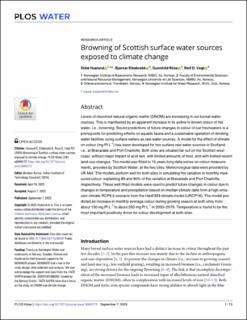| dc.description.abstract | Levels of dissolved natural organic matter (DNOM) are increasing in our boreal watercourses. This is manifested by an apparent increase in its yellow to brown colour of the water, i.e., browning. Sound predictions of future changes in colour of our freshwaters is a prerequisite for predicting effects on aquatic fauna and a sustainable operation of drinking water facilities using surface waters as raw water sources. A model for the effect of climate on colour (mg Pt L-1) has been developed for two surface raw water sources in Scotland, i.e., at Bracadale and Port Charlotte. Both sites are situated far out on the Scottish west coast, without major impact of acid rain, with limited amounts of frost, and with limited recent land-use changes. The model was fitted to 15 years long data-series on colour measurements, provided by Scottish Water, at the two sites. Meteorological data were provided by UK Met. The models perform well for both sites in simulating the variation in monthly measured colour, explaining 89 and 90% of the variation at Bracadale and Port Charlotte, respectively. These well fitted models were used to predict future changes in colour due to changes in temperature and precipitation based on median climate data from a high emission climate RCP8.5 scenario from the HadCM3 climate model (UKCP18). The model predicted an increase in monthly average colour during growing season at both sites from about 150 mg Pt L-1 to about 200 mg Pt L-1 in 2050–2079. Temperature is found to be the most important positively driver for colour development at both sites. | en_US |

